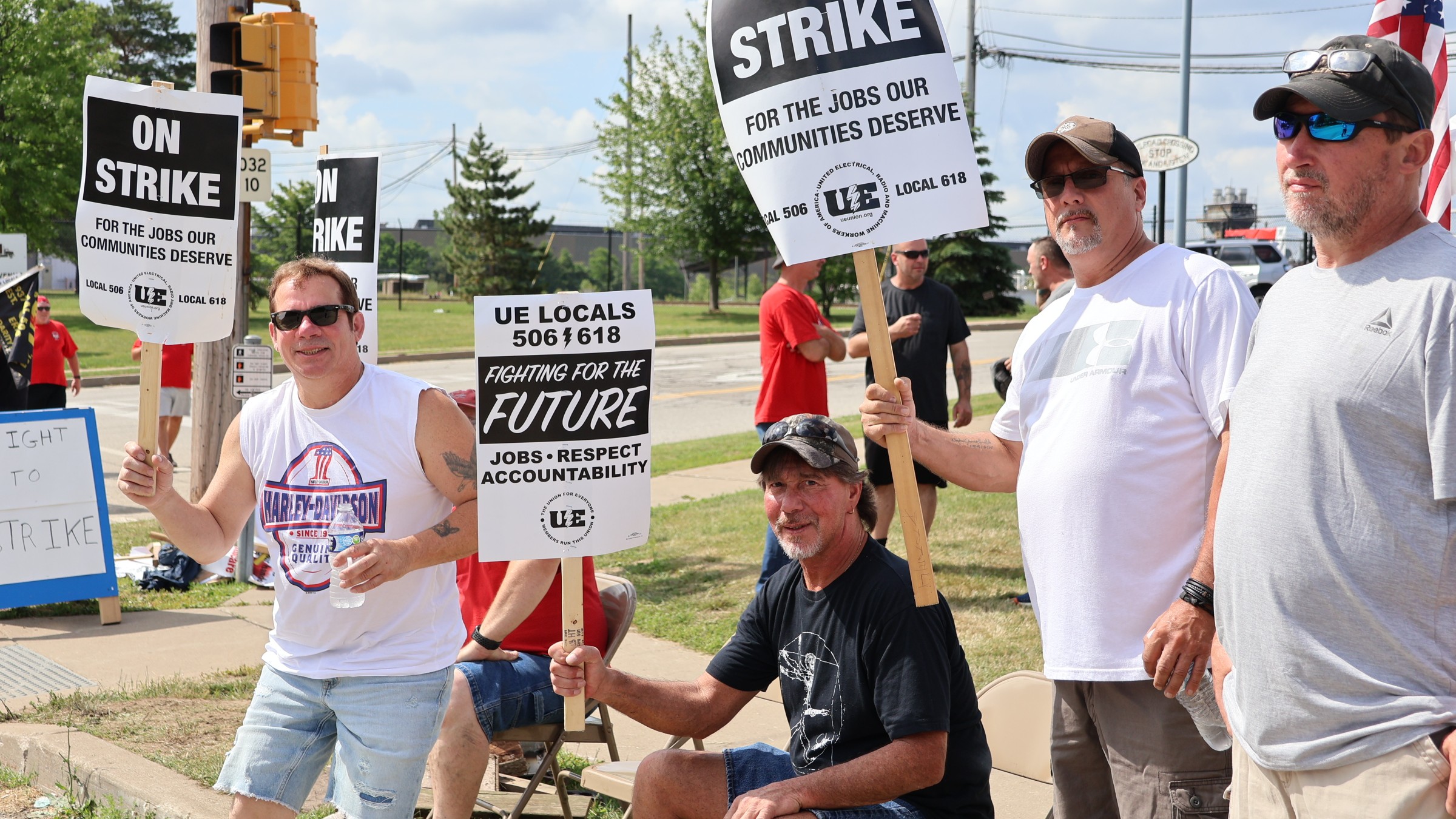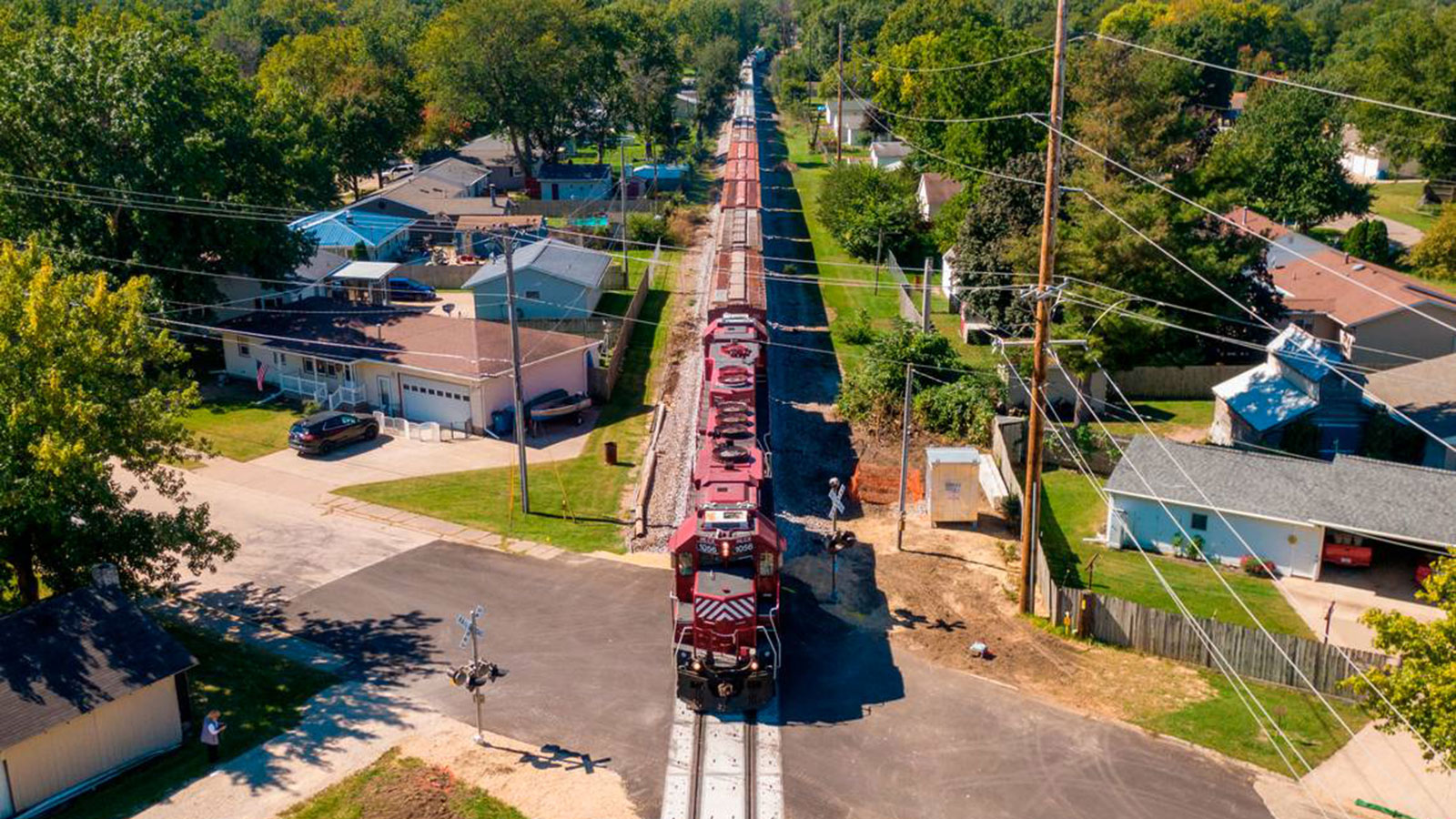Workers in Erie, Pennsylvania, are on strike, asking for familiar items like better pay, voting rights, and health care benefits. They’re also asking for one unique condition: to shift their production plant to greener technology.
The plant workers in Erie, two hours north of Pittsburgh, manufacture locomotives for Wabtec Corporation. Locomotives are the engine of the train and generally run on diesel fuel.
Manufacturing workers have been on strike since June 22 and are represented by the United Electrical, Radio, and Machine Workers of America union, or UE. Initial conversations to renegotiate working contracts began in April. Scott Slawson is the president of the local 506 UE chapter in Erie and said there are currently 1,400 workers on strike.
“The members are dug in for the long haul,” Slawson said. “This is a passionate fight for them and they’re willing to go the distance if required.”
He said his union and train operator unions are working together to push for better environmental standards and greener technology in the industry.
Trains aren’t massive polluters, but the industry is trying to reduce emissions. The transportation industry is responsible for the highest amount of greenhouse gas emission of all industries in the country, with rail being responsible for two percent of the sector’s emissions, according to the U.S. Department of Transportation. Compared to other options, both freight and passenger rail lines emit fewer pollutants than automobiles or planes.
Still, trains are known to release air pollutants in the communities they operate in. For example, diesel emissions are responsible for 70 percent of cancer risk from air pollution in California, and the rail industry releases 640 tons of air pollutants every year in that state alone.* This reality recently pushed California regulators to create the nation’s first emissions regulations for trains.
To prevent pollution, train companies would purchase and use emissions-reducing locomotives, commonly referred to as Tier 4 locomotives, from manufacturers like Wabtec.
These machines decrease emissions by an estimated 70 percent more than their counterparts, according to industry projections. Top rail companies Norfolk Southern and Union Pacific have made pledges to reduce their emissions (30 percent by 2030 and net zero by 2050, respectively) and adopt some of these greener locomotives.
The industry is moving slowly to make this change, according to a report from the investigative labor outlet Workday Magazine and the progressive public policy organization American Prospect. The Environmental Protection Agency told Workday that, as of 2020, 74 percent of all of the locomotives operated by major rail companies are Tier 2 or lower, with almost all smaller rail companies operating outdated, polluting technology.
Slawson wants to speed up this industry shift and said workers are using their voices to get it done. A report from the University of Massachusetts Amherst found that manufacturing green, Tier 4 locomotives at the Erie plant would create between 2,600 and 4,300 estimated new jobs, and additional several thousand in the region.
“It’s not just about building the locomotive; it’s about requiring the rail industry as a whole to make this switch,” Slawson said. “Even though rail is one of the least polluting things out there, there still has to be a push to adopt the newest technologies.”
Organized workplaces and strikes are on the rise across the country. Industries across the nation are now dealing with the realities of what the transition away from fossil fuel dependency logistically looks like. The UE has said its industry is deeply tied to fossil fuel usage to power the cars they create and they want to break ties with the polluting past.
“The company is not willing to make commitments towards assisting us in this venture and they’re not willing to make commitments to the workforce to allow us to do this,” Slawson said, “and that’s a problematic piece of this.”
In a statement to Grist, a Wabtec spokesperson said the company is disappointed the union has engaged in a strike and that “no one benefits from a walkout.”
“The company is a leader with a proven track record in developing environmentally zero or low-emission locomotives for the rail industry,” Tim Bader, Wabtec spokesperson said.
In addition to the Tier 4 locomotives, Wabtec also manufactures a green technology locomotive that is 100 percent battery-powered, known as a FLXdrive. Bader said Erie engineers, who are not striking, do significant design work for these locomotives, but the manufacturing is done on a “case-by-case basis factoring in plant capacity, location, cost competitiveness, and schedule.”
Bader said most of the Tier 4 manufacturing is being done in Fort Worth, Texas.
Past labor battles over a green transition have been rooted in anxiety that as industries try and pivot away from fossil fuel use or polluting machinery, workers would be left in the lurch. This has played out before when offshore wind came to Texas and oil workers worried the transition would leave them behind.
But, this doesn’t mean that workers in these industries don’t support the change. In 2021, 4,500 California oil workers signed on in support of renewable energy projects like wind and solar. That same year, the nation’s largest coal mining union announced its support for clean energy projects, albeit with a few caveats.
Liz Ratzloff said the ongoing strike in Pennsylvania is an example of how industries not directly operating in fossil fuels are moving towards greeners solutions and their workers are demanding they be active participants in any sort of transition.
[Read next: The shared history of unions and the environmental justice movement]
Ratzloff is the co-executive director of the Labor Network for Sustainability, a nonprofit advocacy group focused on the intersection of labor organizing and climate action. She said as the nation pushes for more renewable technologies in transportation, it makes sense the frontline workers creating those products are organizing.
“These companies are using this point of transition as a way to undo a lot of labor standards that have been won,” Ratzloff said.
Right now, the auto industry is preparing for a round of labor negotiations. The United Auto Workers, or UAW, are advocating for a guaranteed transition for workers who currently manufacture gas-powered vehicles to the manufacturing of EVs. The union, which represents roughly 400,000 active workers across the country, has criticized the lower pay associated with EV production. UAW has also called out the Biden administration for not requiring union laborers and fair pay standards when giving federal subsidies to EV manufacturers.
She said the strike in Pennsylvania echoes similar pushes in auto manufacturing to decarbonize and manufacture electric vehicles, all with fair pay. Auto industry workers who manufacture electric vehicles are often paid less than their legacy coworkers who create gas-powered vehicles, she said. For example, a battery cell manufacturing plant in Lordstown, Ohio currently has a starting wage of $16.50 an hour, with the chance to make up to $20 per hour after seven years. The plant, a General Motors project, replaced an assembly plant that closed in 2019 where GM union workers made double the current starting pay.
Ratzloff said the fight in Pennsylvania goes behind a push for a green transition and is ensuring that workers continue to have rights and a say in their jobs as the industry changes.
“[The Wabtec strike] shows the potential power of workers, communities, and the labor movement in addressing the climate crisis where companies are uninterested and unwilling, and the government is seemingly unable,” she said.
*Correction: This story originally misstated the amount of cancer risk attributable to diesel emissions from locomotives in California.




